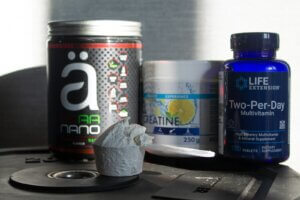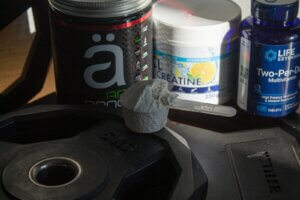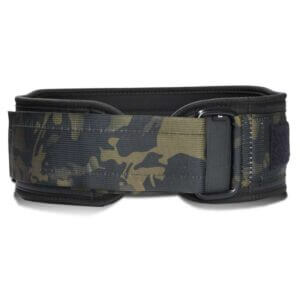How to Front Squat

Introduction:
The front squat is a foundational exercise in CrossFit and weightlifting, emphasizing strength, stability, and mobility. It is a compound movement that primarily targets the quadriceps, while also engaging the core, glutes, and upper back. This exercise not only builds leg strength but also enhances overall athletic performance and functional fitness. Whether you’re a beginner or at an intermediate level, this guide will help you understand the technique and benefits of the front squat.
Steps in the Front Squat movement:
Setup:
- Begin by standing with your feet shoulder-width apart.
- Position the barbell on the rack at about shoulder height.
- Step under the bar, bringing it to rest on the front deltoids and clavicles.
- Create a “shelf” by lifting your elbows high and keeping your upper arms parallel to the ground.
Grip:
- Use a clean grip (fingers under the bar, elbows high) or cross your arms over the bar to hold it in place.
- Ensure the barbell is balanced on your shoulders and close to your throat without choking you.
Unrack:
- Stand up to lift the bar off the rack, stepping back to clear the rack.
- Position your feet shoulder-width apart, toes slightly turned out.
Descent:
- Initiate the squat by bending at the hips and knees simultaneously.
- Keep your chest up and elbows high throughout the movement.
- Descend until your thighs are at least parallel to the ground, maintaining a neutral spine.
Ascent:
- Drive through your heels to stand up, extending your hips and knees simultaneously.
- Keep your core engaged and chest up, returning to the starting position.
What Equipment is needed
- Barbell: A standard Olympic barbell is ideal for front squats.
- Squat Rack: Provides a safe and convenient way to position the barbell at the correct height.
- Weight Plates: To add resistance and progressively overload the muscles.
- Lifting Shoes (optional): Provide stability and support, especially for those with limited ankle mobility.
- Lifting belt
Investing in quality equipment can significantly impact your front squat performance and safety. A sturdy squat rack is indispensable, providing adjustable heights to accommodate different lifters and ensuring safe racking and unracking of the barbell. An Olympic barbell with appropriate knurling offers a secure grip, essential for maintaining control during the lift. Weight plates with clear markings allow for precise load adjustments, facilitating progressive overload. Lifting shoes with an elevated heel can enhance ankle mobility and promote an upright torso, crucial for front squats. Additionally, accessories like wrist wraps can provide support, especially for those with limited wrist flexibility. Incorporating a front squat harness can alleviate strain on the wrists and shoulders, allowing for a more comfortable lifting experience.
Check out the Equipment subsite for more tools, tips, and inspiration.
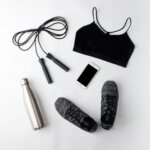
Shop Fitness gear now on Amazon
See Amazons extensive range of workout gear here. (Affiliate Link)
Scaling Options:
To gradually build strength and proficiency, consider the following scaling options:
- Goblet Squat: Hold a dumbbell or kettlebell close to your chest if you’re not yet comfortable with the barbell.
- Front Squat with Dumbbells: Use dumbbells in place of a barbell to build strength and practice the movement pattern.
- Box Squat: Use a box to set a consistent depth and provide support during the movement.
Common Mistakes to Avoid:
- Dropping Elbows: Keep your elbows high to maintain an upright torso and prevent the bar from rolling forward.
- Knees Caving In: Focus on pushing your knees out to maintain proper alignment and prevent injury.
- Rounding the Back: Engage your core and keep your chest up to maintain a neutral spine throughout the squat.
Benefits of the Movement:
- Quad Strength: The front squat places greater emphasis on the quadriceps compared to the back squat.
- Core Stability: Holding the barbell in the front rack position challenges the core to stabilize the spine.
- Improved Mobility: Enhances flexibility in the hips, ankles, and thoracic spine.
- Functional Fitness: Transfers to athletic movements like jumping, running, and lifting.
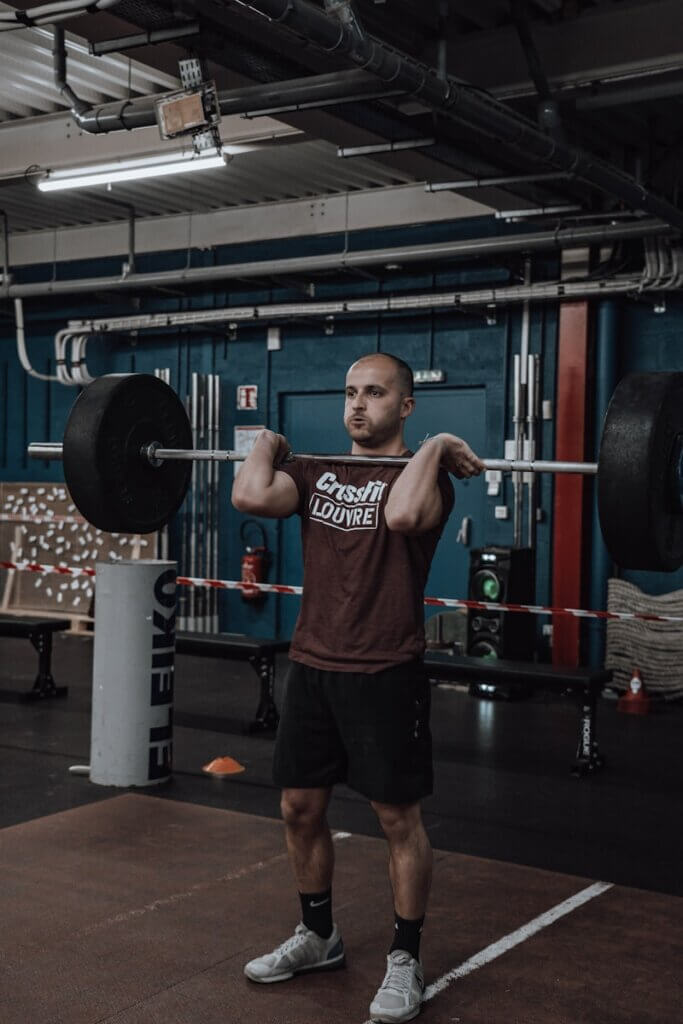
Which Muscles Are Worked:
During this exercise, the following muscle groups are engaged:
- Primary Muscles: Quadriceps, glutes, hamstrings.
- Secondary Muscles: Core stabilizers (abdominals and obliques), upper back (trapezius, rhomboids).
Alternative Similar Movements:
If you’re seeking variation or targeting specific muscle groups, consider incorporating these alternative exercises:
- Back Squat: Barbell placed on the back, emphasizing the posterior chain.
- Overhead Squat: Holding a barbell overhead, increasing the challenge to balance and stability.
- Goblet Squat: Holding a weight in front of the chest, similar movement pattern with less load.
- Split Squat: One foot forward and one foot back, focusing on unilateral leg strength.

Shop Fitness gear now on Amazon
See Amazons extensive range of workout gear here. (Affiliate Link)
Mobility and Flexibility Requirements for Front Squats
Executing a proper front squat demands significant mobility in various joints and muscle groups. Ankles, hips, and thoracic spine flexibility are crucial to maintain an upright torso and achieve adequate squat depth. Limited ankle dorsiflexion can cause the heels to lift, compromising balance and form. Similarly, tight hip flexors may restrict the depth of your squat, while a stiff thoracic spine can lead to a forward-leaning posture, increasing the risk of injury. Incorporating dynamic stretches and mobility drills into your warm-up routine can address these issues. Ankle mobility exercises, such as calf stretches and ankle rotations, can enhance dorsiflexion. Hip openers like the pigeon pose or deep lunges can improve hip flexibility. Thoracic spine mobility can be increased through foam rolling and thoracic extensions. Regularly performing these exercises not only aids in achieving proper front squat form but also contributes to overall movement efficiency and injury prevention.
Breathing Techniques to Enhance Performance
Proper breathing is a pivotal yet often overlooked component of front squat performance. Employing the Valsalva maneuver—a technique where you take a deep breath and hold it while descending—can create intra-abdominal pressure, stabilizing the spine and providing a solid core foundation. Begin by inhaling deeply into your diaphragm before initiating the squat. Hold your breath during the descent and the initial phase of the ascent. Exhale forcefully as you pass the most challenging part of the lift, typically when rising past parallel. This method not only enhances core stability but also aids in maintaining an upright torso, crucial for front squat execution. However, individuals with cardiovascular concerns should consult a healthcare professional before practicing the Valsalva maneuver, as it can temporarily elevate blood pressure.
Progressive Overload Strategies
To continually develop strength and muscle through front squats, implementing progressive overload is essential. This principle involves gradually increasing the stress placed on the body during training to stimulate adaptation. Start by incrementally adding weight to the barbell, ensuring that form and technique remain uncompromised. Alternatively, increasing the number of sets and repetitions can enhance training volume. Incorporating tempo variations, such as slowing down the eccentric (lowering) phase or adding pauses at the bottom of the squat, can also intensify the exercise without additional weight. Monitoring your progress through a training log can help in planning systematic increases and identifying plateaus. Remember, the goal is to challenge the muscles progressively while allowing adequate recovery to prevent overtraining and reduce the risk of injury.
Integrating Front Squats into a Comprehensive Training Program
While front squats are a valuable exercise, their effectiveness is maximized when integrated into a well-rounded training regimen. Consider incorporating front squats on lower body-focused days, complementing them with posterior chain exercises like deadlifts or Romanian deadlifts to ensure balanced muscle development. Pairing front squats with upper body pulling movements, such as pull-ups or rows, can create a balanced session that promotes overall strength. Additionally, including unilateral leg exercises like lunges or step-ups can address muscle imbalances and enhance stability. Periodizing your training by varying intensity and volume can prevent plateaus and promote continuous progress. For instance, alternating between heavy, low-repetition days and lighter, high-repetition days can target different muscle fibers and energy systems. Always prioritize proper warm-up and cool-down routines, incorporating mobility and flexibility work to maintain joint health and prevent injuries. By thoughtfully integrating front squats into a comprehensive program, you can achieve balanced development and optimize your training outcomes.

Shop Fitness gear now on Amazon
See Amazons extensive range of workout gear here. (Affiliate Link)
Q&A on Front Squats
How to do proper front squats?
Follow the step-by-step guide in this article. Key points include keeping your chest up, elbows high, and maintaining a neutral spine.
Why are front squats hard?
Front squats require significant core stability and upper body strength to keep the barbell in place, making them more challenging than back squats.
Are front squats easy?
For many, front squats are not easy due to the demand on the core and the need to maintain proper posture throughout the movement.
What is the most comfortable way to do a front squat?
Using lifting shoes can provide better stability and comfort. Additionally, finding a grip (clean grip or crossed-arm) that works best for you is essential.
Do front squats build abs?
Yes, front squats engage the core muscles significantly, helping to build and strengthen the abs.
Is front squat more quad dominant?
Yes, the front squat places more emphasis on the quadriceps compared to the back squat.
Are front squats harder on knees?
Front squats can be harder on the knees if performed with improper form. Keeping the knees aligned and not letting them cave in is crucial.
How deep should you go for a front squat?
Aim to descend until your thighs are at least parallel to the ground, maintaining a neutral spine throughout the movement.
How to keep elbows up in front squat?
Focus on keeping your upper arms parallel to the ground and actively engage your upper back muscles to keep your elbows high.
Are front squats better for long legs?
Front squats can be more challenging for people with long legs due to the need for greater mobility, but they can still be beneficial with proper technique.
Are front squats more athletic?
Front squats are often considered more athletic as they require balance, core strength, and mobility, which are crucial for athletic performance.
Are squats better for glutes or quads?
Front squats target the quads more, while back squats are generally better for glute development.
Can you front squat every day?
While possible, front squatting every day can lead to overtraining and injury. It’s essential to allow adequate recovery time.
Why are front squats uncomfortable?
The front rack position can be uncomfortable due to wrist and shoulder mobility limitations. Gradually improving flexibility can help.
Can you go heavy on front squats?
Yes, you can go heavy on front squats, but ensure you have proper form and core stability to avoid injury.
Why is my front squat so weak?
A weak front squat can be due to a lack of core stability, upper back strength, or proper technique. Consistent practice and strengthening these areas will help.
How to not choke during front squat?
Ensure the barbell rests on your shoulders and not directly on your throat. Keeping elbows high helps position the bar correctly.
How to correctly front squat?
Refer to the detailed steps in this article for proper technique. Key points include maintaining an upright torso, keeping elbows high, and engaging the core.
Is a 70 kg front squat good?
A 70 kg front squat is a solid achievement, especially for beginners and intermediate lifters. It indicates good strength and form.
Is front squat worth doing?
Absolutely, front squats are excellent for building quad strength, core stability, and improving overall athletic performance.
Do bodybuilders front squat?
Yes, many bodybuilders include front squats in their routines to build quadriceps and core strength, and to add variety to their leg workouts.
Conclusion:
Incorporating the front squat into your training regimen can significantly enhance your lower body strength, core stability, and overall athletic performance. By mastering the proper technique and avoiding common mistakes, you’ll be well on your way to achieving your fitness goals. So, step up to the bar, lift those elbows high, and squat your way to a stronger, more resilient body!

Shop Fitness gear now on Amazon
See Amazons extensive range of workout gear here. (Affiliate Link)

